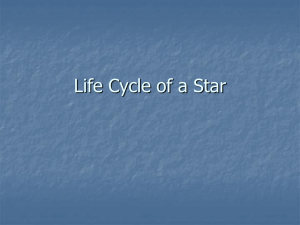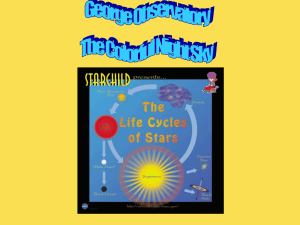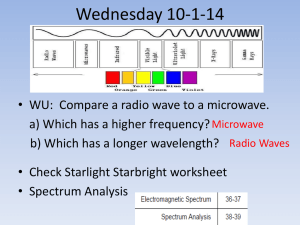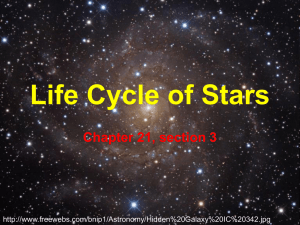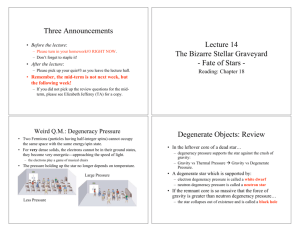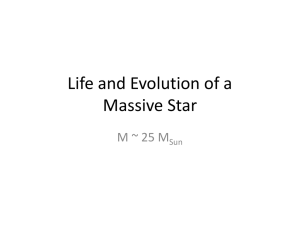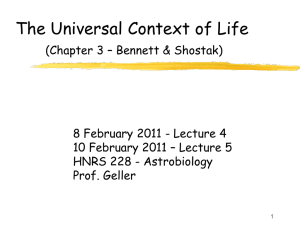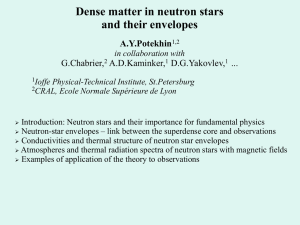File
advertisement
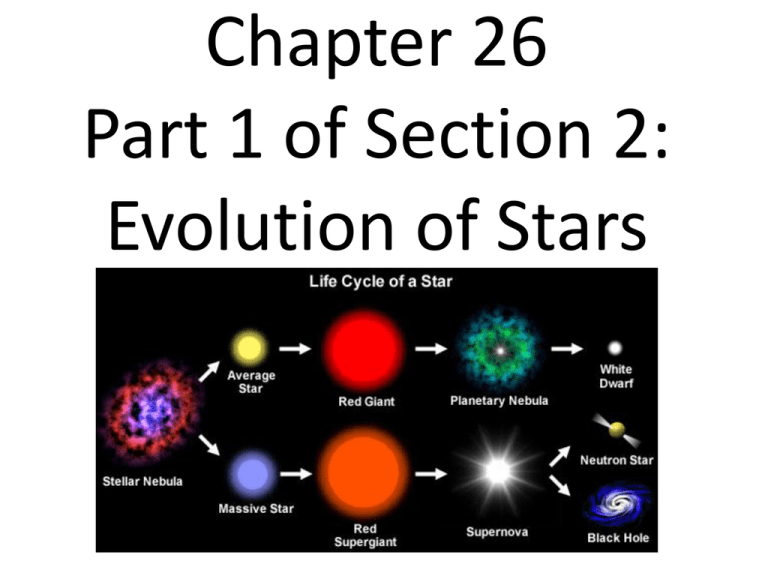
Chapter 26 Part 1 of Section 2: Evolution of Stars How Do Stars Form? • Formation begins with condensation of a large cloud of cold gas, ice, and dust called a nebula. • The nebula contracts, breaks into fragments, and increases in temperature. • When the center of the cloud reaches 2 million degrees F (1 million K), it becomes a protostar. • When the temperature reaches 18 million degrees F (10 million K), the hydrogen fuses to become helium and a star is born. H-R Diagram: Hertzsprung and Russell • Early 1900’s chart to compare the temperature of a star to its luminosity (magnitude). • Higher temperature stars have higher magnitudes (radiate more energy) • 90% of all stars are found in the main sequence of the diagram. How do Stars Change? • A star like our Sun was probably 100 x’s bigger as a protostar. • As it continues to form it shrinks, becomes more dense, and increases in temperature. • The protostar has a large amount of hydrogen in it. • The hydrogen begins to fuse together to form helium. • The energy of hydrogen fusion is that of a bomb. Stellar Equilibrium • Equilibrium (balance) is attained when the outward force of fusion is = to the inward pull of gravity. • When a star reaches equilibrium it will be found in the main sequence of the H-R diagram. • Stars spend most of their lives in equilibrium (main sequence). • Our Sun has been in equilibrium for approximately 5 billion years. Losing Equilibrium • When a star has fused all of its hydrogen into helium it begins to lose equilibrium because the outward force from fusion becomes less than the inward force of gravity. • What a star becomes next depends on its mass. • The bigger the mass of a star, the shorter its life and more dramatic its death will be. Stars Smaller than our Sun • • • • • 80% of stars in the universe are smaller than our Sun. These are called red dwarfs. Proxima Centauri is a red dwarf. Could remain on main sequence for 16 trillion years. Slowly fade away Average Size Stars Like Our Sun • Our sun is considered a medium sized yellow dwarf. • As the Sun fuses hydrogen the outer layers will expand and our sun becomes a red giant. • When the Sun runs out of hydrogen in approx. 5 billion years, gravity will begin to take over and crush the star inward. • This makes the star hotter. Hot enough to fuse helium into heavier elements like carbon and stop the crushing force of gravity. • The fusion of helium causes the outer layer to swell so much that it escapes the gravity of the star and is released into space. • What’s left behind is a white dwarf. The White Dwarf • Is it the final stage for medium size stars? • For our Sun- YES. • For stars that are part of a binary system or star cluster- NO (on next slide) • The white dwarf is the dense core left behind from the previous red giant. • 1 tsp. of white dwarf matter would have a mass of several tons. • This will continue to shine for billions of years. If the Star is Part of a Binary System or Star Cluster… • It’s not over for the dying white dwarf. • More than ½ of the stars are part of a binary system. • The dying white dwarf can steal hydrogen from its binary partner and grow in mass to an unstable limit 40% higher than our Sun. • This leads to Type 1 A Supernova. Stars 8-10 x’s More Massive Than Our Sun • • • • These are called supergiants. Example of a supergiant is Betelgeuse. Hydrogen fuses to become helium Higher temperatures allow helium to fuse to become carbon or oxygen. • Carbon and Oxygen can further fuse to become even heavier elements which leads to elements like iron and nickel. • It cannot fuse iron any further so gravity takes over and the star collapses leaving a core the size of the Earth. • This causes a Type 2 Supernova releasing heavy elements into space. After a Type 2 Supernova: The Neutron Star and Pulsar • The remaining dense core is made up almost entirely of neutrons. • This is called a neutron star. • These are as small as 10 miles across. • They are extremely dense. • 1 tsp. of neutron star matter = 1 billion tons • The Neutron star begins to spin rapidly and create a large magnetic field that begins to glow. • This is called a pulsar. (Like a lighthouse) Stars that are 25-40 x’s the Mass of the Sun • Also called Supergiants • So massive that even the neutron star cannot hold up under the pressure of gravity. • When the neutron star collapses it becomes a black hole. Black Holes • Ultimate death of a VERY massive supergiant. • A region of space with such high density and gravity that nothing can escape it.


